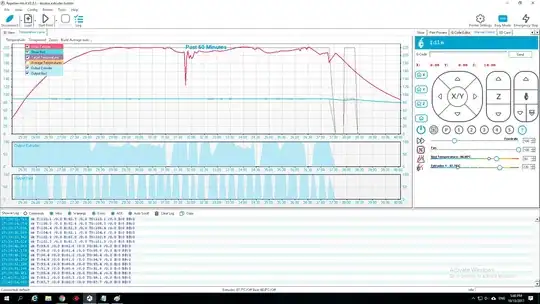I saw that you said you switched to a RAMPS 1.4 . I'll warn you that the componetry for the cheap $20 RAMPS 1.4's have significant issues, including under-speccing parts, using wrong part, not including enough copper for traces on the boards, and other quality concerns that can equal "FIRE" (not a euphemism).
You've noticed temperature fluctuations as well, as seen in the graph. This could be the result of a few different things.
You din't PID tune the Hotend. Read M303 for the full way to do this. Then either using EEPROM or by compiling the Kp, Ki, Kd variables, and store them in your configuration.h (assuming you're using Marlin).
Your thermistor is loose. When it heats, it loosens and creates a 'not great' contact against the hotend, giving spotty results.
HOWEVER the really concerning thing is that the power MOSFET isn't specced high enough for you board. If you've noticed it very hot to the touch, and also collaborated by a really 'squirrely' heated bed graph, then you have some significant problems with this part.
There is a solution. But you ever hear the adage "If you buy cheap, prepare to buy thrice." ? It applies in your situation. Because in order to route around the crappy MOSFET, you need an external MOSFET board.
THIS is a good place to see what part I'm talking about, common places to buy them (Amazon and eBay are good for quicker, and Aliexpress is cheaper and longer). The aforementioned link also includes wiring diagrams and setup.
So, it looks like a set of problems, with only 1 actually costing money. And ideally, those MOSFET boards are around $10 from Amazon(Prime), or up to $20 for the really nice TriGorilla ones.
IF/WHEN you buy a Power MOSFET board, make sure to EXCEED the amount of watts when compared to your heating solution. If you're using 12v, then you need an ohmmeter to get the resistance of the board.
Solve for amps:
Amperage = volts/resistance
Then once you have amps, take:
amps*volts = watts
This is how much watts your heated bed uses. MAKE SURE TO EXCEED THIS BY 10%

 By my mistake 12v in heatbed Vout plug and then the temperature shows(ramps 1.6)
Plase help me
By my mistake 12v in heatbed Vout plug and then the temperature shows(ramps 1.6)
Plase help me